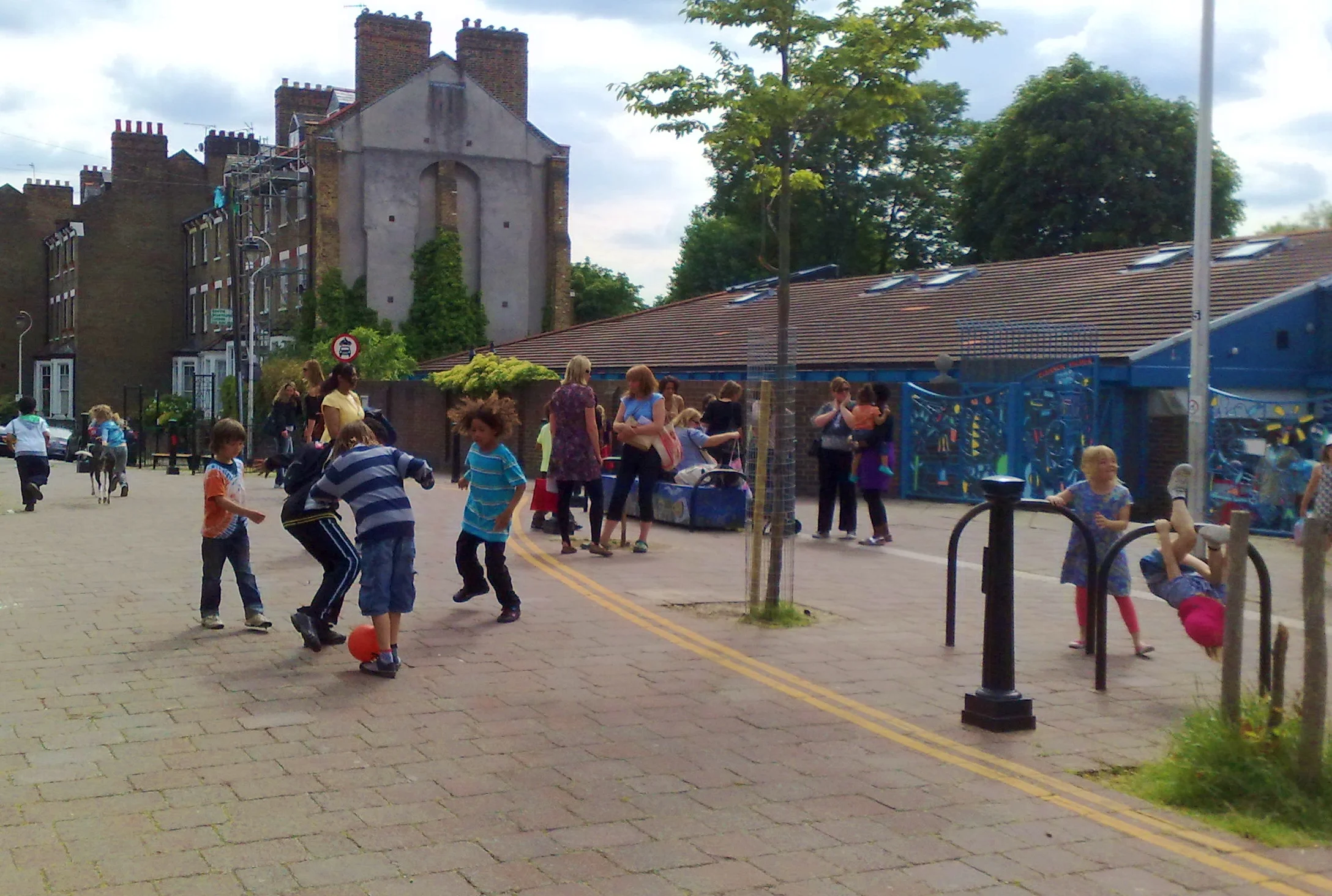Author: Tim Gill
My last post argued that municipal champions have a crucial role in making neighbourhoods more child-friendly. This post gives four examples of how civil society agencies, alliances and partnerships – especially those at national, regional and local levels – can build momentum and action. It draws on over a quarter of a century of personal experience, largely in high-income, global North contexts (though not entirely).
The national NGO route: play advocacy in the UK
I am going to start by looking at the UK some 25 years ago. Back then, the level of political interest in children’s spatial freedoms was close to zero. The NGO I managed at the time, the Children’s Play Council, which became Play England, was invisible to all but a handful of play advocates. Yet within ten years or so, the agency was supporting government investment of hundreds of millions of pounds in play facilities.[i] It was also leading a campaign for home zones child-friendly residential streets encompassing radical designs, pedestrian priority and slow speed limits: a campaign that led to new laws and government funding for dozens of pilot schemes across the UK. How did this striking change come about?

A pilot home zone scheme outside a school in London © Tim Gill
The shift partly reflected a rapidly changing political climate. 1997 saw the arrival of an ambitious, socially progressive UK government. After decades of neglect of cities, political leaders were talking of an urban renaissance. At the same time, shocking cases of child neglect shone a light on systematic failings in state support for children and families, fueling a holistic policy focus on the health and wellbeing of all children. We were able to join these dots and strengthen the case for change. [bctt tweet=”One clear moral here is the need for advocates to pay close attention to the political weather: to be on the alert for signs of change, and ready to build their case with an incoming administration” username=”cities4children”].[ii]
Yet this is not the full story. There were also aspects about the ‘play lobby’ (for want of a better phrase) that made a difference. One distinctive feature of the UK is the existence of longstanding, national play NGOs for each of the home nations. Play England, Play Wales, Play Scotland and Playboard Northern Ireland each bring together local and national agencies involved in improving children’s access to outdoor play, , including campaigning charities, service providers, support agencies and municipalities.
Grounded in shared values rooted in the UN Convention on the Rights of the Child, they lead campaigns, deliver programmes, act as a focal point for dialogue with government, and work in partnership with other NGOs and the private sector. All four are well positioned to work closely with government, and have received public funding. Yet each has an independent board, and considerable freedom of action.
One vital feature is a link with the local. As I argue in Urban Playground, the main services and functions that shape children’s spatial lives – planning, transport, parks, education, housing – are delivered locally. The kind of initiatives that take child-friendly planning forward – pilot schemes, demonstration projects, engagement exercises – all demand engagement at the local level, and this experience in turn needs to be captured and the lessons learnt.
Hence it is no surprise that in some British cities, local or regional versions of national play NGOs have emerged. In my own city, London Play supports adventure playgrounds and other supervised play services across the capital, and has also been a catalyst for the introduction of home zones, play streets and other street reclaiming initiatives.
Play-oriented NGOs are having an impact on towns and cities around the world. Play Australia, for example – originally a regional body – is leading an ambitious nationwide programme to create 1000 play streets. In the USA, the national NGO Kaboom! offers a more delivery-focused model. Founded in the wake of the tragic death of two children playing in an abandoned car, Kaboom! originally focused on community playground build projects in underserved neighbourhoods. Today, its diverse programme includes ‘Play Everywhere’ an initiative to create playful public spaces beyond the playground.
The research route: From scholarship to action in Flanders
Belgium provides a contrasting case study, in the form of the regional Flemish NGO Kind & Samenleving (‘Children and Society’ in English). It grew not out of play advocacy, but from academic work on the sociology of childhood, before moving into action-oriented research and support for policy and practice change.
Like the UK play umbrella bodies discussed above, K &S sees municipalities as key change agents, and has developed creative tools for decision-makers and practitioners. This model, bringing together research and practice, exists in Canada and the USA, and has potential in other parts of the world.

This ‘speelweefsel’ or ‘play space web’ map – a tool developed by Flemish NGO K & S – shows the planning of a child-friendly walking route in a regeneration area of Ghent © City of Ghent
The community route: bottom-up action as a force for change
Sometimes, social change emerges from bottom-up action by communities themselves. The NGO Playing Out was started in 2009 by a small group of mothers in Bristol, UK, who wanted their streets to be less car-dominated. Their practical, scalable model of regular, short sessions of community-led street play has now been taken up by communities across the UK and beyond, reaching over 1500 streets in over 100 municipalities, with similar schemes also emerging in low- and middle-income countries including Brazil, India and Mexico. Playing Out is also an effective advocate for children’s rights. For example, highlighting the impact of lockdown measures on children during the Covid-19 pandemic.
Movimento Boa Praça in Sao Paulo, Brazil is another example of a growing bottom-up movement to engage municipalities, inform/change policies and developing tools for transforming neighbourhoods. The NGO was started in 2008 by a mother determined to improve local neighbourhood play opportunities for her daughter. It has since grown into a national movement to support play and social life in public space.
The community of interest route: playground safety as a consensus-building topic
Sometimes, structures evolve out of the nature of the issue. Playground safety, for example, is an emotive, complex topic with different agencies coming from radically different starting points. Hence building consensus – identifying all the key stakeholders, and keeping everyone inside the tent – is crucial. The UK Play Safety Forum (which I have belonged to for decades, and now chair) shows that this approach can have an impact even without huge financial resources.
Despite being unfunded and having no separate legal status, this work has led to a fundamental reframing of play safety, away from an ever more restrictive safety culture that almost everyone agreed was problematic, and towards a balanced, thoughtful approach: namely, risk benefit assessment (RBA). This game-changing move gained high-level endorsement from government regulators and has spread well beyond the UK.
In Canada, this work directly inspired a diverse coalition of agencies to come together to draw up a statement on outdoor play that has helped to reframe that country’s conversation about risk.[iii] It even influenced a precedent-setting legal case. RBA is set to have a global impact, in the form of a proposed new international industry standard on risk management in play and recreation, where the idea of balance is written into the title of the document.
How could new organisations be nurtured? One potential incubator is UNICEF’s Child-friendly City Initiative. In Germany, the CFCI is delivered through a separate national NGO created through a partnership with an existing children’s NGO, and has reached over 20 municipalities.[iv] In one – Regensburg – a scheme to create a new inclusive play space received a UNICEF Cities Inspire award in 2021. Several other countries including Austria and Colombia are run in partnership with NGOs and associations of mayors/municipalities [link]. Another international NGO, the International Play Association with member groups in around 20 countries, has supported coalitons in informal contexts and crisis situations, where improving play opportunities can have a dramatic impact but existing agencies may lack expertise.
In truth, no initiative or organisational structure comes with a guarantee of progress. Indeed, in England, the past decade or so has seen a downturn in government investment and interest that has been almost as dramatic as the upturn that preceded it. While the routes described above are perhaps more well-trodden in high income countries, agencies like Movimento Boa Praça point to their viability well beyond the Global North. Established international NGOs like UNICEF and the International Play Association, as well as more recent partnerships and initiatives such as Urban95 and indeed Cities4Children, can play a role in forging links and sharing lessons. Whatever the local or national context, civil society is much more likely to have a sustained impact if it builds on the solid foundations of consensus-building, collaboration across silos, smart political engagement, and strong links to local delivery.
This blog is the final blog of a series by play expert Tim Gill, founder of Rethinking Childhood and author of bestselling RIBA book Urban Playground: How Child-Friendly Planning and Design Can Save Cities.
The Ideas4Action series aims to inspire with ideas that have worked in other cities and countries so that you too, can take action in your own city. Read more of our blogs here.
Endnotes
[i] Voce A (n.d.) Policy for Play. Policy Press. Available at: https://policy.bristoluniversitypress.co.uk/policy-for-play
[ii] Gill T (2015) Play in the good times: the (English) inside story. International Journal of Play 4(3). Routledge: 236–240. DOI: 10.1080/21594937.2015.1106043.
[iii] Tremblay MS, Gray C, Babcock S, et al. (2015) Position Statement on Active Outdoor Play. International Journal of Environmental Research and Public Health 12(6): 6475–6505. DOI: 10.3390/ijerph120606475.
[iv] KINDERFREUNDLICHE and KOMMUNEN (2019) Good Practice in Child Friendly Cities. Berlin. Available at: https://www.kinderfreundliche-kommunen.de/fileadmin/kfkfiles/DOKUMENTE/1._KFK_Verein/Bilanzbroschuere-2019-ENG_FINAL.pdf
This work is licensed under a Creative Commons Attribution-NonCommercial-NoDerivatives 4.0 International License. When re-sharing this content please ensure accreditation by adding the following sentence: ‘This blog was first published by the Global Alliance – Cities4Children (www.cities4children.org/blog).’

